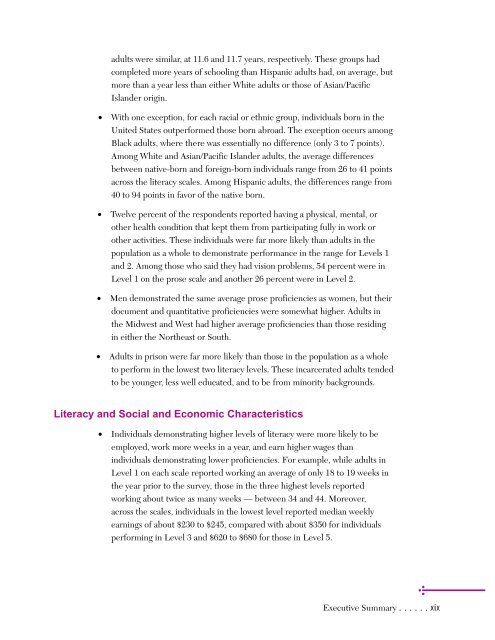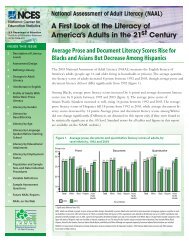Adult Literacy in America - National Center for Education Statistics ...
Adult Literacy in America - National Center for Education Statistics ...
Adult Literacy in America - National Center for Education Statistics ...
Create successful ePaper yourself
Turn your PDF publications into a flip-book with our unique Google optimized e-Paper software.
adults were similar, at 11.6 and 11.7 years, respectively. These groups had<br />
completed more years of school<strong>in</strong>g than Hispanic adults had, on average, but<br />
more than a year less than either White adults or those of Asian/Pacific<br />
Islander orig<strong>in</strong>.<br />
• With one exception, <strong>for</strong> each racial or ethnic group, <strong>in</strong>dividuals born <strong>in</strong> the<br />
United States outper<strong>for</strong>med those born abroad. The exception occurs among<br />
Black adults, where there was essentially no difference (only 3 to 7 po<strong>in</strong>ts).<br />
Among White and Asian/Pacific Islander adults, the average differences<br />
between native-born and <strong>for</strong>eign-born <strong>in</strong>dividuals range from 26 to 41 po<strong>in</strong>ts<br />
across the literacy scales. Among Hispanic adults, the differences range from<br />
40 to 94 po<strong>in</strong>ts <strong>in</strong> favor of the native born.<br />
• Twelve percent of the respondents reported hav<strong>in</strong>g a physical, mental, or<br />
other health condition that kept them from participat<strong>in</strong>g fully <strong>in</strong> work or<br />
other activities. These <strong>in</strong>dividuals were far more likely than adults <strong>in</strong> the<br />
population as a whole to demonstrate per<strong>for</strong>mance <strong>in</strong> the range <strong>for</strong> Levels 1<br />
and 2. Among those who said they had vision problems, 54 percent were <strong>in</strong><br />
Level 1 on the prose scale and another 26 percent were <strong>in</strong> Level 2.<br />
• Men demonstrated the same average prose proficiencies as women, but their<br />
document and quantitative proficiencies were somewhat higher. <strong>Adult</strong>s <strong>in</strong><br />
the Midwest and West had higher average proficiencies than those resid<strong>in</strong>g<br />
<strong>in</strong> either the Northeast or South.<br />
• <strong>Adult</strong>s <strong>in</strong> prison were far more likely than those <strong>in</strong> the population as a whole<br />
to per<strong>for</strong>m <strong>in</strong> the lowest two literacy levels. These <strong>in</strong>carcerated adults tended<br />
to be younger, less well educated, and to be from m<strong>in</strong>ority backgrounds.<br />
<strong>Literacy</strong> and Social and Economic Characteristics<br />
• Individuals demonstrat<strong>in</strong>g higher levels of literacy were more likely to be<br />
employed, work more weeks <strong>in</strong> a year, and earn higher wages than<br />
<strong>in</strong>dividuals demonstrat<strong>in</strong>g lower proficiencies. For example, while adults <strong>in</strong><br />
Level 1 on each scale reported work<strong>in</strong>g an average of only 18 to 19 weeks <strong>in</strong><br />
the year prior to the survey, those <strong>in</strong> the three highest levels reported<br />
work<strong>in</strong>g about twice as many weeks — between 34 and 44. Moreover,<br />
across the scales, <strong>in</strong>dividuals <strong>in</strong> the lowest level reported median weekly<br />
earn<strong>in</strong>gs of about $230 to $245, compared with about $350 <strong>for</strong> <strong>in</strong>dividuals<br />
per<strong>for</strong>m<strong>in</strong>g <strong>in</strong> Level 3 and $620 to $680 <strong>for</strong> those <strong>in</strong> Level 5.<br />
Executive Summary ......xix



